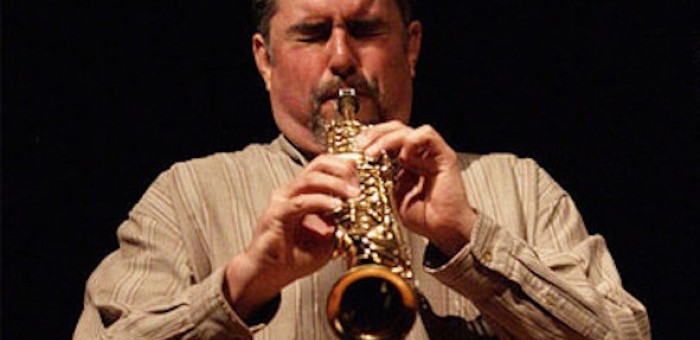Jun 3, 2025 11:25 AM
In Memoriam: Al Foster, 1943–2025
Al Foster, a drummer regarded for his fluency across the bebop, post-bop and funk/fusion lineages of jazz, died May 28…

Tony Malaby (seen here in a press photo) performed with three ensembles at Elastic Arts in Chicago on March 24–25.
(Photo: Claudio Casanova)There was a time in jazz when all roads led to New York. Tenor and soprano saxophonist Tony Malaby took that road when he left his home state of Arizona in 1995.
Since then, he’s been a versatile and robust contributor to the city’s jazz scene, with a CV that includes an early stint with the Mingus Big Band and recent work with Fred Hersch, as well as leading or co-leading several strikingly different bands. There’s the lyrical and hard-swinging Paloma Recia with guitarist Ben Monder, bassist Eivind Opsvik, and drummer Nasheet Waits; Tubacello, a quartet with tubist Dan Peck, cellist Christopher Hoffman and drummer John Hollenbeck, that thrives on the textural contrasts of its titular instruments; and Tamarindo, a free-flowing trio with Waits and bassist William Parker.
But as busy as Malaby is in New York, he’s also made it a point to work for extended periods with musicians in other locales, such as the 10-day residency he spent in Bogotá, Colombia, in 2013. So he was a natural first choice when Chicago’s Elastic Arts, a non-profit space on the city’s north side, decided to begin hosting musicians for extended sojourns.
Malaby had already played with Chicago-based musicians, most notably on the CD Warblepeck (Songlines) with cellist Fred Lonberg-Holm. On March 23, Malaby commenced two days of improvisation workshops for young musicians at Elastic Arts, and also began rehearsing with the nine established locals who would accompany him for a performance there on March 24–25.
Malaby performed with three different groups during his residency, appearing on opening night with two small groups, each of which showcased a different side of his improvisational acumen. First, Malaby joined Lonberg-Holm and percussionist Michael Zerang for a set of suspenseful, no-holds-barred free improvisation.
The cellist, who currently uses electronics to transform the voice of his instrument, and the percussionist have been playing together as a duo and with musicians like John Butcher and Joe McPhee for over 20 years, so part of Malaby’s challenge was to find a way into a well-established dialogue. He did so by proposing contrasts in tone, timbre and content, culminating in an extraordinary passage where he and Lonberg-Holm simultaneously sustained dueling lines.
There was music on the stands for the second March 24 set, in which pianist Paul Giallorenzo, bassist Jason Roebke, and drummer Charles Rumback played Malaby’s compositions. This set proposed two additional elements of the saxophonist’s music—an approach to rhythm that uses swing as an opening gambit ripe for deconstruction, and a close attention to dynamics of density and volume.
On March 25, Malaby led nine local musicians (Dave Rempis, alto saxophone; Jason Stein, bass clarinet; Tim Daisy, drums; Josh Berman, cornet; Jason Adasiewicz, vibraphone; and Giallorenzo, Roebke, Rumback and Lonberg-Holm) through arrangments by pianist Kris Davis. The presence of mallets and extra percussion gave the Chicago ensemble a fuller, less brassy sound than can be heard on the recording Novela (Clean Feed).
Despite having just two days of rehearsal, the players were well attuned to the music’s requirements; Malaby did not have to stand up and guide them, but did most of his conducting with small glances delivered while he played his horns.
The Davis/Malaby book does not treat the ensemble as either a “big small group” or a “little big band,” but as a phenomenon unto itself, one that is capable of both great flexibility and considerable complexity. The Chicagoans heeded Malaby’s command to attend to dynamics, which enabled the music to move fluidly between stark exposition and careful articulation of layered textures. Even Malaby’s own solos were expressions of the music’s total logic.
While solos and duets afforded the players opportunities to display their individual voices, they also required them to be mindful contributors to the balance of a large and living group sound. While the music’s bold and sometimes clashing sonorities can be characterized as free-jazz, this was in fact music of great specificity. It also expressed considerable emotional range, by turns tender on “Mother’s Love” and quite playful on “Warblepeck.” DB

Foster was truly a drummer to the stars, including Miles Davis, Sonny Rollins and Joe Henderson.
Jun 3, 2025 11:25 AM
Al Foster, a drummer regarded for his fluency across the bebop, post-bop and funk/fusion lineages of jazz, died May 28…

“Branford’s playing has steadily improved,” says younger brother Wynton Marsalis. “He’s just gotten more and more serious.”
May 20, 2025 11:58 AM
Branford Marsalis was on the road again. Coffee cup in hand, the saxophonist — sporting a gray hoodie and a look of…

“What did I want more of when I was this age?” Sasha Berliner asks when she’s in her teaching mode.
May 13, 2025 12:39 PM
Part of the jazz vibraphone conversation since her late teens, Sasha Berliner has long come across as a fully formed…

Roscoe Mitchell will receive a Lifetime Achievement award at this year’s Vision Festival.
May 27, 2025 6:21 PM
Arts for Art has announced the full lineup for the 2025 Vision Festival, which will run June 2–7 at Roulette…

Benny Benack III and his quartet took the Midwest Jazz Collective’s route for a test run this spring.
Jun 3, 2025 10:31 AM
The time and labor required to tour is, for many musicians, daunting at best and prohibitive at worst. It’s hardly…